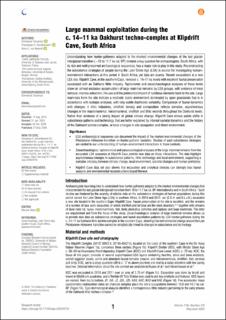Large mammal exploitation during the c. 14-11 ka Oakhurst techno-complex at Klipdrift Cave, South Africa
Journal article, Peer reviewed
Published version

Åpne
Permanent lenke
https://hdl.handle.net/11250/2760810Utgivelsesdato
2020Metadata
Vis full innførselSamlinger
Originalversjon
South African Journal of Science. 2020, 116 (5/6), 6754. https://doi.org/10.17159/sajs.2020/6754Sammendrag
Understanding how hunter-gatherers adapted to the marked environmental changes of the last glacialinterglacial transition (~18 to 11.7 ka cal. BP) remains a key question for archaeologists. South Africa, with its rich and well-preserved archaeological sequences, has a major role to play in this study. Reconstructing the subsistence strategies of people during the Later Stone Age (LSA) is crucial for investigating human– environment interactions at this period in South Africa, yet data are scarce. Recent excavations at a new LSA site, Klipdrift Cave, in the southern Cape, revealed c. 14–11 ka levels with excellent faunal preservation associated with an Oakhurst lithic industry. Taphonomic and zooarchaeological analyses of these levels show an almost exclusive accumulation of large mammal remains by LSA groups, with evidence of meat removal, marrow extraction, fire use and the preferential import of nutritious elements back to the site. Large mammals from the site indicate a relatively stable environment dominated by open grasslands that is in accordance with isotopic analyses, with only subtle diachronic variability. Comparison of faunal dynamics with changes in lithic industries, shellfish density and composition reflects complex, asynchronous changes in the macromammal, micromammal, shellfish and lithic records throughout the Oakhurst levels. Rather than evidence of a strong impact of global climate change, Klipdrift Cave shows subtle shifts in subsistence patterns and technology that are better explained by internal societal dynamics and the history of the Oakhurst techno-complex, or local changes in site occupation and direct environment.
